Shrinkage methods
Feature Engineering in R

Jorge Zazueta
Research Professor and Head of the Modeling Group at the School of Economics, UASLP
Two common regularization techniques
Lasso
- Adds penalty term proportional to absolute value of model weights
- Encourages some weights to become exactly zero
- Effectively eliminates the corresponding features
- Can be an automated feature selection method
Ridge
- Adds penalty term proportional to square of model weights
- Does not shrink some coefficients to zero like Lasso
- But can effectively reduce overfitting
A first look at Lasso
Set up the model
recipe <- # Define recipe
recipe(Loan_Status ~ ., data = train) %>%
step_normalize(all_numeric_predictors()) %>%
step_dummy(all_nominal_predictors()) %>%
update_role(Loan_ID, new_role = "ID")
# set up model
model_lasso_manual <- logistic_reg() %>%
set_engine("glmnet") %>%
set_args(mixture = 1, penalty = .2)
# Bundle in workflow
workflow_lasso_manual <-
workflow() %>%
add_model(model_lasso_manual) %>%
add_recipe(recipe)
Fit and inspect
fit_lasso_manual <- # Fit workflow
workflow_lasso_manual %>%
fit(train)
#Inspect coefficients
tidy(fit_lasso_manual)
# A tibble: 15 × 3
term estimate penalty
<chr> <dbl> <dbl>
1 (Intercept) -0.816 0.2
2 ApplicantIncome 0 0.2
3 CoapplicantIncome 0 0.2
4 LoanAmount 0 0.2
5 Loan_Amount_Term 0 0.2
6 Credit_History -0.220 0.2
7 Gender_Female 0 0.2
... ... ...
Simple logistic regression vs. Lasso
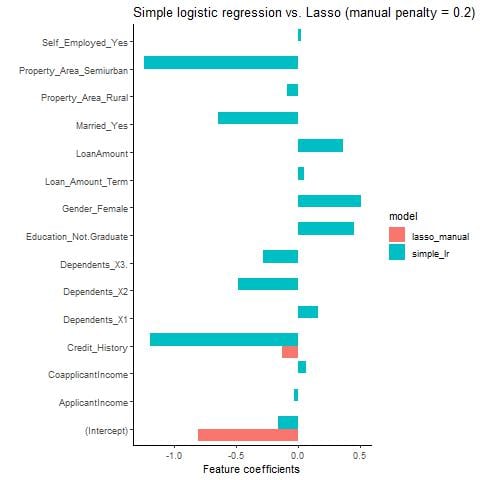
Hyperparameter tuning
Setting a model with tuning
model_lasso_tuned <- logistic_reg() %>%
set_engine("glmnet") %>%
set_args(mixture = 1,
penalty = tune())
workflow_lasso_tuned <-
workflow() %>%
add_model(model_lasso_tuned) %>%
add_recipe(recipe)
penalty_grid <- grid_regular(
penalty(range = c(-3, 1)),
levels = 30)
Looking at the tuning output
tune_output <- tune_grid(
workflow_lasso_tuned,
resamples = vfold_cv(train, v = 5),
metrics = metric_set(roc_auc),
grid = penalty_grid)
autoplot(tune_output)
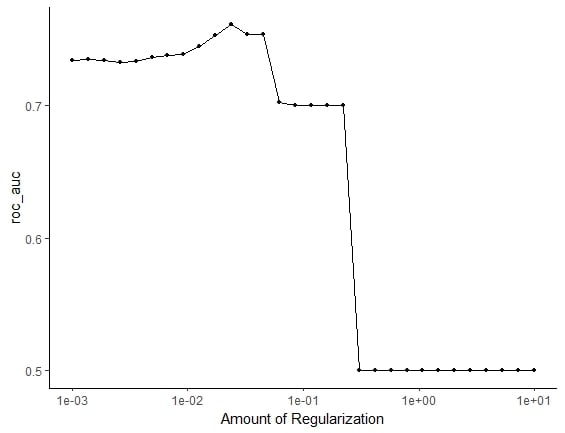
Exploring the results
Auto-chosen features
best_penalty <-
select_by_one_std_err(tune_output,
metric = 'roc_auc', desc(penalty))
# Fit Final Model
final_fit<-
finalize_workflow(workflow_lasso_tuned,
best_penalty) %>%
fit(data = train)
final_fit_se %>% tidy()
# A tibble: 15 × 3
term estimate penalty
<chr> <dbl> <dbl>
1 (Intercept) -0.660 0.0452
2 ApplicantIncome 0 0.0452
3 CoapplicantIncome 0 0.0452
4 LoanAmount 0 0.0452
5 Loan_Amount_Term 0 0.0452
6 Credit_History -0.948 0.0452
7 Gender_Female 0 0.0452
8 Married_Yes -0.191 0.0452
9 Dependents_X1 0 0.0452
10 Dependents_X2 0 0.0452
11 Dependents_X3. 0 0.0452
12 Education_Not.Graduate 0 0.0452
13 Self_Employed_Yes 0 0.0452
14 Property_Area_Rural 0 0.0452
15 Property_Area_Semiurban -0.163 0.0452
Simple logistic regression vs. tuned Lasso
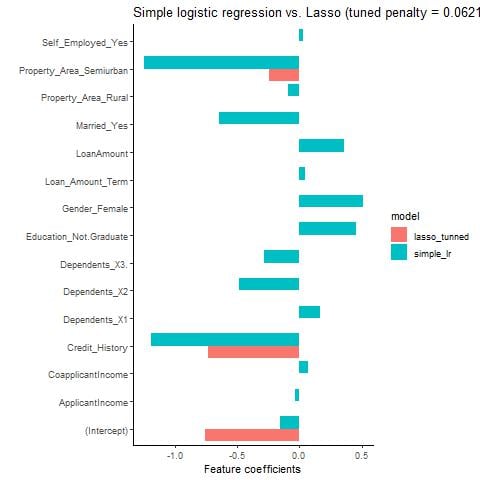
Ridge regularization
Ridge is the option when mixture = 0
model_ridge_tuned <- logistic_reg() %>%
set_engine("glmnet") %>%
set_args(mixture = 0, penalty = tune())
workflow_ridge_tuned <-
workflow() %>%
add_model(model_ridge_tuned) %>%
add_recipe(recipe)
tune_output <- tune_grid(
workflow_ridge_tuned,
resamples = vfold_cv(train, v = 5),
metrics = metric_set(roc_auc),
grid = penalty_grid)
tune_output <- tune_grid(
workflow_ridge_tuned,
resamples = vfold_cv(train, v = 5),
metrics = metric_set(roc_auc),
grid = penalty_grid)
autoplot(tune_output)
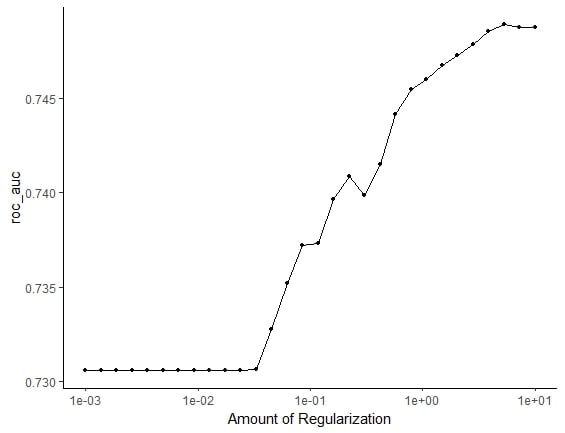
Ridge regularization
best_penalty <-
select_by_one_std_err(tune_output,
metric = 'roc_auc', desc(penalty))
best_penalty
final_fit<-
finalize_workflow(workflow_ridge_tuned,
best_penalty) %>%
fit(data = train)
tidy(final_fit)
# A tibble: 15 × 3
term estimate penalty
<chr> <dbl> <dbl>
1 (Intercept) -0.799 10
2 ApplicantIncome 0.00232 10
3 CoapplicantIncome 0.0000537 10
4 LoanAmount 0.00291 10
5 Loan_Amount_Term 0.00161 10
6 Credit_History -0.0245 10
7 Gender_Female 0.00850 10
8 Married_Yes -0.0140 10
9 Dependents_X1 0.00497 10
10 Dependents_X2 -0.0100 10
11 Dependents_X3. 0.00259 10
12 Education_Not.Graduate 0.00308 10
13 Self_Employed_Yes 0.00892 10
14 Property_Area_Rural 0.0109 10
15 Property_Area_Semiurban -0.0139 10
Ridge vs. Lasso
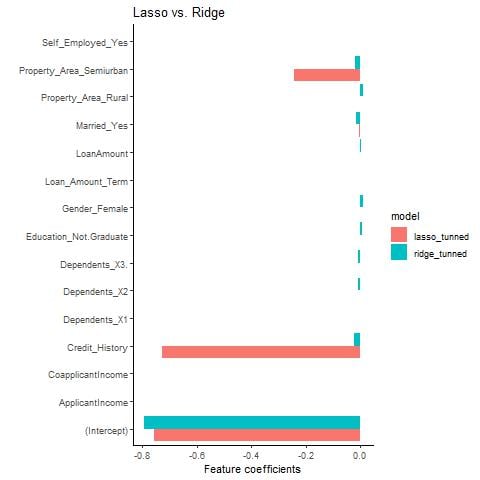
Let's practice!
Feature Engineering in R

